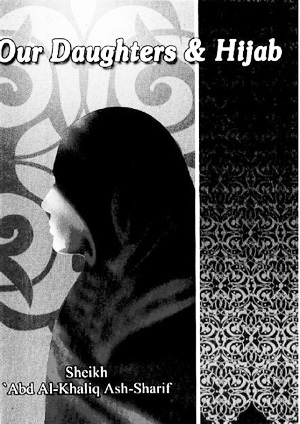Hub For Your Daily Islamic Insights 🕋 🕌

Our Daughters & Hijab, A thoughtful guide on the importance of hijab for young women
A thoughtful guide on the importance of hijab for young women
Free
Discover the profound wisdom and guidance offered in 'Our Daughters & Hijab' by Sheikh 'Abd Al-Khaliq Ash-Sharif. This enlightening book delves into the importance of hijab from an Islamic perspective, providing families with clear, practical advice on nurturing strong values and understanding the deeper meaning behind the hijab. Perfect for parents and young readers alike, this resource empowers families to foster meaningful conversations and strengthen their faith together. The paperback edition comes in a convenient 6 x 9 inch size, making it easy to read at home or take on the go. Whether you’re looking to enrich your family’s spiritual journey or seeking answers to common questions about hijab, this book is an indispensable addition to your Islamic library.
### Our Daughters & Hijab: A Thoughtful Guide on the Importance of Hijab for Young Women In the journey of life, young women encounter a myriad of choices that shape their identities and values. One significant choice is the decision to wear the hijab, a practice that holds profound spiritual and cultural significance for many. This guide aims to explore the importance of the hijab for young women, empowering them with knowledge and understanding as they navigate this pivotal aspect of their identity. #### Understanding the Hijab The hijab is often perceived solely as a piece of clothing, but it represents much more than that. For countless Muslim women, the hijab serves as a symbol of faith, modesty, and personal empowerment. The word "hijab" primarily means covering or veil in Arabic, and it is commonly worn by Muslim women as an expression of their religious beliefs and commitment to God. From the perspective of Islamic teachings, the hijab is not merely an obligation; it is a means to maintain dignity and respect in a society that can often misinterpret the complexities of femininity. By choosing to wear the hijab, young women may also invite curiosity and dialogue about their faith, fostering a deeper understanding among diverse communities. #### The Spiritual Dimension At its core, the hijab is a tool for spiritual growth and a manifestation of piety. For young women, wearing the hijab can serve as a reminder of their beliefs and obligations to live a life that honors those values. In the Quran, Allah emphasizes modesty, which is not limited to attire but extends to behavior, speech, and overall demeanor. By adopting the hijab, young women signify their commitment to embody these principles. Moreover, many women report feeling a stronger connection to their faith when they wear the hijab. It becomes an integral part of their relationship with God and a daily testament of their devotion. This connection can foster a sense of peace, confidence, and purpose in an often chaotic world. #### A Personal Choice One of the most essential aspects of wearing the hijab is recognizing it as a personal choice. Every young woman must arrive at this decision based on her understanding of faith, personal values, and individual circumstances. This choice should be respected and supported, whether her decision leans towards wearing the hijab full-time, occasionally, or not at all. Encouraging open dialogues about the hijab can help dismantle stereotypes and foster a culture of respect for individual choices. Families and communities should cultivate an environment where young women feel comfortable discussing their feelings about wearing a hijab, allowing them to explore the rationale behind their choices without fear or judgement. #### Empowerment Through Modesty Some may argue that the hijab restricts women, but many young women find the opposite to be true: wearing the hijab empowers them. Modesty, as articulated in the wearing of the hijab, allows young women to rebel against societal norms that often prioritize appearance over substance. It offers a powerful statement that a woman’s worth is not dictated by her physical beauty but by her character and actions. In a world rife with unrealistic beauty standards and objectification, the hijab can serve as an act of defiance. It provides a sense of control over how one is perceived and the ability to define one’s own identity without succumbing to external pressures. Moreover, the hijab can create a sense of solidarity among women who share similar experiences, fostering an empowering sense of community. #### Navigating Societal Pressures Despite the empowerment associated with wearing the hijab, young women may still encounter societal pressures and challenges. Misunderstandings and prejudices can arise, leading to uncomfortable situations. It’s imperative for them to be equipped with knowledge, not only about the hijab’s significance but also about how to respond to misconceptions. Educational discussions in schools and community centers about the diverse practices and beliefs surrounding the hijab can cultivate empathy and understanding, reducing bias and fostering acceptance. When young women are well-informed and confident about their choices, they become resilient in facing potential criticisms. #### The Role of Family and Community Family support is crucial for young women contemplating the hijab. Parents and guardians should engage in meaningful conversations about the significance of the hijab, its implications and allow their daughters to express their thoughts freely. Creating a supportive environment will enable young women to make informed decisions and feel less isolated in their journey. Additionally, community support is vital. Establishing networks, including mentorship programs that connect young women with those who have embraced the hijab, can provide guidance and encouragement. These mentors can impart valuable insights about their personal experiences, troubleshoot common concerns, and foster connections among peers facing similar choices. #### Conclusion: The Journey of Acceptance The journey of understanding and accepting the hijab is deeply personal. As young women explore this choice, they must be encouraged to reflect on their values, beliefs, and lived experiences. The decision to wear the hijab should come from a place of personal conviction and understanding, supported by families and communities that cherish individuality and empower voices. Rather than viewing the hijab through a singular lens, it is vital to appreciate the multifaceted nature of this choice. The hijab is not just a garment; it is a powerful expression of faith, identity, autonomy, and social connection. In supporting our daughters in their journey towards understanding the hijab, we empower them to navigate their paths with confidence and integrity, honoring their choices while promoting a deeper dialogue about faith and identity in our contemporary world.
